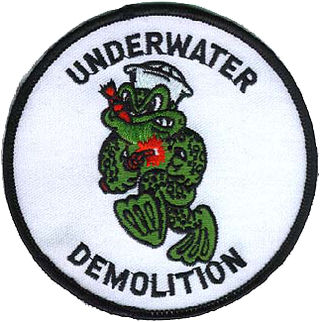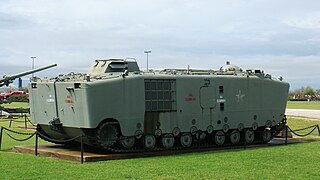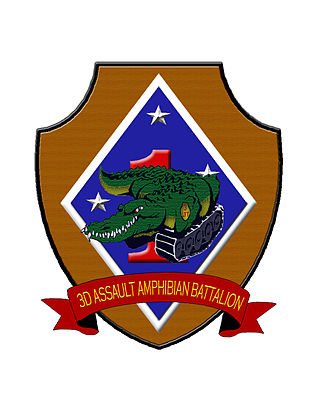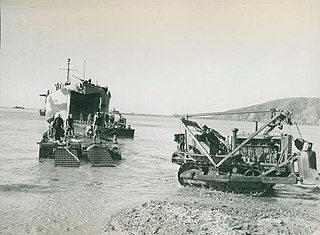
Marine Corps Base Camp Pendleton is the major West Coast base of the United States Marine Corps and is one of the largest Marine Corps bases in the United States. It is on the Southern California coast in San Diego County and is bordered by Oceanside to the south, San Clemente and Orange County to the north, Riverside County to the northeast, and Fallbrook to the east.

The Underwater Demolition Team (UDT), or frogmen, were amphibious units created by the United States Navy during World War II with specialized non-tactical missions. They were predecessors of the navy's current SEAL teams.

The Assault Amphibious Vehicle (AAV)—official designation AAVP-7A1 —is a fully tracked amphibious landing vehicle manufactured by U.S. Combat Systems.

Joint Expeditionary Base–Little Creek (JEB–LC), formerly known as Naval Amphibious Base Little Creek and commonly called simply Little Creek, is the major operating base for the Amphibious Forces in the United States Navy's Atlantic Fleet. The base comprises four locations in three states, including almost 12,000 acres (4,900 ha) of real estate. Its Little Creek location in Virginia Beach, Virginia, totals 2,120 acres (860 ha) of land. Outlying facilities include 350 acres (140 ha) located just north of Training Support Center Hampton Roads in Virginia Beach and 21 acres (8.5 ha) known as Radio Island at Morehead City, North Carolina, used for U.S. Coast Guard ships and personnel as well as serves as an amphibious embarkation/debarkation area for U.S. Marine Corps units at Marine Corps Base Camp Lejeune, North Carolina. It is also home to the Naval School of Music.

The Amphibious Vehicle, Tracked (LVT) is an amphibious warfare vehicle and amphibious landing craft, introduced by the United States Navy and United States Marine Corps. The United States Army, Canadian Army and British Army used several LVT models during World War II, and referred to those vehicles as "Landing Vehicle, Tracked."

The Battle of Tinian was part of the Pacific campaign of World War II, fought on the island of Tinian in the Mariana Islands from 24 July until 1 August 1944. The 8,000-man Japanese garrison was eliminated, and the island joined Saipan and Guam as a base for the Twentieth Air Force.

Edson Range is a firing range complex at Marine Corps Base Camp Pendleton, near Oceanside, California. It is named for Marine Major General "Red Mike" Edson, "a World War II Medal of Honor recipient and a distinguished small arms marksman proponent." This rifle-qualification complex is home to four of the largest firing ranges on the base. The range became operational on August 21, 1964, the same day that Camp Calvin B. Matthews, in La Jolla, California, was closed and turned over to the University of California. Camp Matthews had previously been used for rifle training.

The Battle of Kwajalein was fought as part of the Pacific campaign of World War II. It took place 31 January – 3 February 1944, on Kwajalein Atoll in the Marshall Islands. Employing the hard-learned lessons of the Battle of Tarawa, the United States launched a successful twin assault on the main islands of Kwajalein in the south and Roi-Namur in the north. The Japanese defenders put up stiff resistance, although outnumbered and under-prepared. The determined defense of Roi-Namur left only 51 survivors of an original garrison of 3,500.

The Republic of Korea Marine Corps, also known as the ROK Marine Corps, ROK Marines or South Korean Marine Corps, is the naval infantry of South Korea. The ROKMC is a branch of the Republic of Korea Navy responsible for amphibious operations, and also functions as a rapid reaction force and a strategic reserve.

The LVTP-5 is a family of amphibious armored fighting vehicles used by the Philippine Marine Corps and, formerly, the United States Marine Corps. It was designed by the BorgWarner company and built by FMC along with a few other companies. It was first accepted into service in 1956. Some 1,124 basic units were produced, plus the specialist variants, and many saw action in the Vietnam War.

3rd Assault Amphibian Battalion is one of two active duty assault amphibian battalions in the United States Marine Corps. The battalion's primary weapon system is the Amphibious Assault Vehicle or AAV. The AAV is a 27.5-ton armored vehicle that carries up to 21 combat-loaded Marines and is armed with the UGWS, which mounts a .50 cal (12.7 mm) M2HB machine gun and a Mk-19 40 mm grenade launcher. The battalion is also equipped with the Amphibious Combat Vehicle or ACV, a rather new variant to the USMC’s amphibious armament which will replace the AAV in years to come. The AAV ACV are the only armored vehicles in the U.S. inventory that are fully capable of operations both on land and in the ocean. The battalion is part of the 1st Marine Division and the I Marine Expeditionary Force. The unit is based in Camp Pendleton, California.

2nd Assault Amphibian Battalion is a mechanized battalion of the United States Marine Corps. Their primary weapon system is the Amphibious Assault Vehicle. The battalion is a separate battalion within the 2nd Marine Division and the II Marine Expeditionary Force. The unit is based out of the Camp Lejeune, North Carolina

The Combat Assault Battalion was a mechanized battalion of the United States Marine Corps and subordinate element of the 3rd Marine Division and the III Marine Expeditionary Force. The unit was last based at Camp Schwab, Okinawa, Japan.

The Civil Engineer Corps (CEC) is a staff corps of the United States Navy. CEC officers are professional engineers and architects, acquisitions specialists, and Seabee Combat Warfare Officers who qualify within Seabee units. They are responsible for executing and managing the planning, design, acquisition, construction, operation, and maintenance of the Navy's shore facilities. The Civil Engineer Corps is under the command of the Chief of Civil Engineers and Commander, Naval Facilities Engineering Systems Command. On 12 August 2022, RADM Dean VanderLey relieved RADM John W. Korka, becoming the 46th commander of NAVFAC and Chief of Civil Engineers.

Naval Base Coronado (NBC) is a consolidated Navy installation encompassing eight military facilities stretching from San Clemente Island, located seventy miles west of San Diego, California, in Los Angeles County, California, to the Mountain Warfare Training Camp Michael Monsoor and Camp Morena, located sixty miles east of San Diego.

The United States Marine Corps (USMC), also referred to as the United States Marines, is the maritime land force service branch of the United States Armed Forces responsible for conducting expeditionary and amphibious operations through combined arms, implementing its own infantry, artillery, aerial, and special operations forces. The U.S. Marine Corps is one of the eight uniformed services of the United States.
The 9th Amphibian Tractor Battalion was an amphibious assault battalion of the United States Marine Corps. The battalion supported the 6th Marine Division during the Battle of Okinawa in World War II.

Austin Roger Brunelli was a highly decorated combat veteran of World War II and the Korean War. As the commanding officer of the 1st Battalion, 24th Marines during the Battle of Iwo Jima, he was awarded the Navy Cross, the United States military's second-highest decoration awarded for valor in combat. He later served as chief of staff of the 1st Marine Division in Korea and commanding general of Camp Lejeune.

Louis Metzger was a decorated United States Marine Corps officer who attained the rank of lieutenant general. He held combat leadership roles in World War II, Korea, and Vietnam and is credited as one of the primary architects of the Marine Corps' armored vehicle force in World War II. Metzger also formed and commanded the 1st Armored Amphibian Battalion during that conflict at age 27.

Amphibious Training Base (ATB)(USNATB) Advance Amphibious Training Base are United States Armed Forces bases used for the training of amphibious warfare. Starting with World War II, United States Navy began large-scale amphibious assaults of beaches. To train troops in the use of Amphibious warfare ships and Amphibious Combat Vehicles the Navy established training bases both on the US mainland and overseas at US Naval Advance Bases. The Training involved the United States Navy working with The United States Marine Corps, United States Army and in later years sometimes the United States Air Force for air support.




















